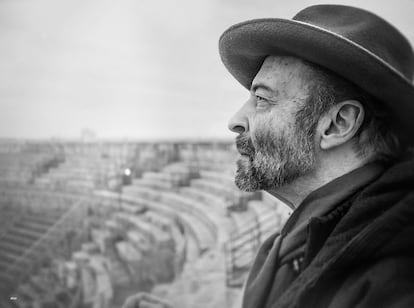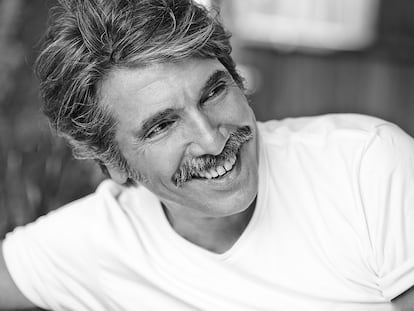Who was René Robert, the flamenco photographer found dead on the streets of Paris?
Friends and colleagues describe the personality and work of the Swiss national, who died in the French capital last week after falling and getting no aid for hours

Swiss photographer René Robert made headlines last week after it emerged that he had died on the streets of Paris from hypothermia on January 19, at the age of 84. He had been left unconscious after a fall, and no one came to his aid for hours, until it was too late. The circumstances of his passing have eclipsed his work, which was dedicated to capturing the essence of flamenco. Friends, colleagues and experts in such photography describe a personality and craft of someone whose death has become a terrible symbol of the dehumanization of people in big cities.
Robert, who was born in Fribourg and is due to be laid to rest today, Monday, in Paris, had a partner, Sabine, for many decades. He discovered the magic of photography at the age of 14, thanks to the father of a friend who developed his images. That’s according to Robert himself, who gave an interview in 2007 to the website Música Alhambra. He sought his fortune in France as a photographer, and in the 1960s he began to frequent Le Catalan, a flamenco venue in Paris. In the aforementioned interview, he explained that he was first attracted by the dancing, while the musical part of the show was “more confusing” to him.
His friend, the journalist Michel Mompontet, who announced his death, describes Le Catalan as the place where the Spanish diaspora would go: the artist Picasso, whose workshop was nearby, as well as the painter Juan Gris. “The old flamenco artists say that you could see and hear both the best and the worst,” Mompontet explains. “Those who were hungry would arrive and they would be given food, drink and a place to sleep.” Mompontet met Robert when he was 20, at the end of the 1980s. At those shows, “there was almost always a very smart-looking gentleman with a spotted handkerchief, hat and a cigarette in his mouth – discreet, but a friend of the artists,” he explains. That man was Robert.
While Robert intimidated him at the start, Mompontet discovered the “simple personality” of a man who worked as a publicity photographer to put food on the table, until his images of flamenco began to be worth something. As the years passed, several generations of artists passed before his lens: Paco de Lucía, Camarón, Chano Lobato, Fernanda de Utrera, Aurora Vargas, Tomatito, Antonio Gades, Cristina Hoyos, Sara Baras, Carmen Linares, Vicente Amigo… “Robert didn’t talk much,” Mompontet recalls. “He was a humanist, with a great sense of irony and he was very kind.”
French photographer Jean-Louis Duzert agrees with this description. “He was humble, he liked to work in the shadows,” he explains. Duzert, a former photojournalist, also discovered flamenco and Robert more or less at the same time. Since then, their friendship and complicity was constant. “We would speak at least once a month to get up to date with shows, concerts…,” he explains. “He would send me his photos and I would send him mine,” he explains, still emotional over the death of someone he saw as a “guide, a master,” and even “a father,” even though there were only 13 years between them. As he wrote in the dedication of one of his books, Robert considered him “a brother of photography.”
Robert published Flamenco (1993), La Rage et la Grâce (or, The rage and the grace, 2001), and Flamenco attitudes (2003). He donated his photographic archives to the National Library of France, and Duzert insists that he was still preparing projects. “We were planning to do a book together about 50 years of flamenco in France,” he explains. “Regrettably, that will no longer happen.”
“Robert didn’t just photograph cantaores and bailaoras [flamenco singers and dancers] but also he tried to portray that kind of catharsis found in flamenco, that tragic spirit, always in black and white,” explains Eduardo Navarro Carrión, cultural manager at the Cervantes Institute in Paris and the organizer of an exhibition that, in 2019, displayed Robert’s photos in Nantes, at the Spanish cinema festival in the same city. Robert explained that when color was used to depict flamenco, it appeared “very touristy” to him. His style was a “very scenic” kind of photography, “in search of the creative moment,” Navarro adds.
“He didn’t want to move to digital,” adds Mompontet. “He liked to develop his photos. It’s curious, because at the same time he was very open to other arts. He loved Caravaggio, his dark scenes, and [flamenco] for him was a tragic representation of life’s extreme feelings. For someone as reserved as he was, that fascinated him.” And despite all of this work, Mompontet explains between giggles, Robert barely spoke any Spanish. “Flamenco is a way of feeling and he had that,” he explains. “That’s why the flamenco artists who were close friends, Camarón, Paco de Lucía, they got along well with him, although I don’t know in which language it was.”
Chema Blanco, an artistic advisor at the Nîmes Flamenco Festival and the director of the Flamenco Biennale in Seville, would share a glass of wine and a lunch with Robert and other figures during the French event. “He was much loved, there were a lot of people who admired him,” he says about this “shortish man.” At those meetings they would discuss “the shows that we had seen. He was very pleasant and had that typically French Bohemian air.” Blanco was impressed how “he looked at and listened to you with close attention.”
Flamenco photographer Paco Sánchez, who has been taking portraits of figures from the flamenco scene for 40 years, points out that Robert’s style is very similar to his. “I discovered him years ago and I was surprised, because I saw myself reflected when I was starting out, in the 1970s, with high-contrast photos in black and white, with the veins on the necks of the singers about to burst and the details of the dancers’ hands.” For Sánchez, he was a photographer who was characterized by “simplicity, very direct.” As for his personality, while he didn’t know him personally, he adds that “he was not much seen in the media, and was sparing in interviews.”
The artistic director of the Picasso Museum in Málaga, southern Spain, José Lebrero, was in charge of the Andalusian Center for Contemporary Art in Seville when it organized a 2009 exhibition, which showed the role of flamenco in photography. Among the 50 or so featured photographers, with 200 or so images on display, was Robert. Lebrero includes him in “the tradition that there was in France with flamenco related to an interest in the exotic.” His work “formed part of a saga in which the dark side of Spain attracted him; it was more about the tavern and the ritual than esthetic excellence.”
With his death, Duzert laments, “a chapter has been closed in the world of flamenco.”
Tu suscripción se está usando en otro dispositivo
¿Quieres añadir otro usuario a tu suscripción?
Si continúas leyendo en este dispositivo, no se podrá leer en el otro.
FlechaTu suscripción se está usando en otro dispositivo y solo puedes acceder a EL PAÍS desde un dispositivo a la vez.
Si quieres compartir tu cuenta, cambia tu suscripción a la modalidad Premium, así podrás añadir otro usuario. Cada uno accederá con su propia cuenta de email, lo que os permitirá personalizar vuestra experiencia en EL PAÍS.
¿Tienes una suscripción de empresa? Accede aquí para contratar más cuentas.
En el caso de no saber quién está usando tu cuenta, te recomendamos cambiar tu contraseña aquí.
Si decides continuar compartiendo tu cuenta, este mensaje se mostrará en tu dispositivo y en el de la otra persona que está usando tu cuenta de forma indefinida, afectando a tu experiencia de lectura. Puedes consultar aquí los términos y condiciones de la suscripción digital.
More information
Archived In
Últimas noticias
Most viewed
- Sinaloa Cartel war is taking its toll on Los Chapitos
- Oona Chaplin: ‘I told James Cameron that I was living in a treehouse and starting a permaculture project with a friend’
- Reinhard Genzel, Nobel laureate in physics: ‘One-minute videos will never give you the truth’
- Why the price of coffee has skyrocketed: from Brazilian plantations to specialty coffee houses
- Silver prices are going crazy: This is what’s fueling the rally










































